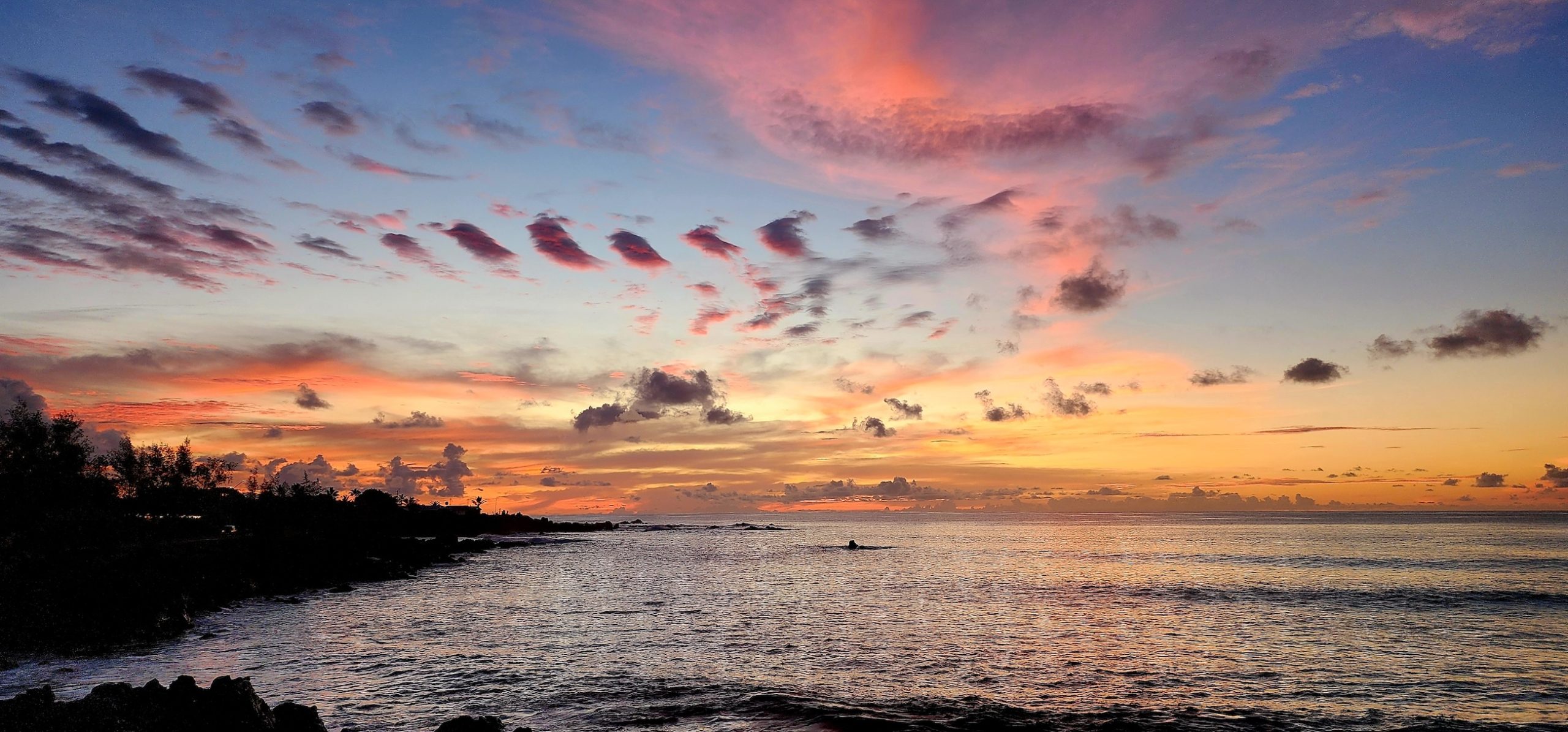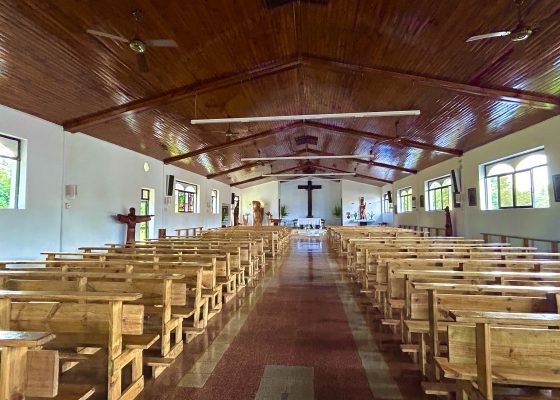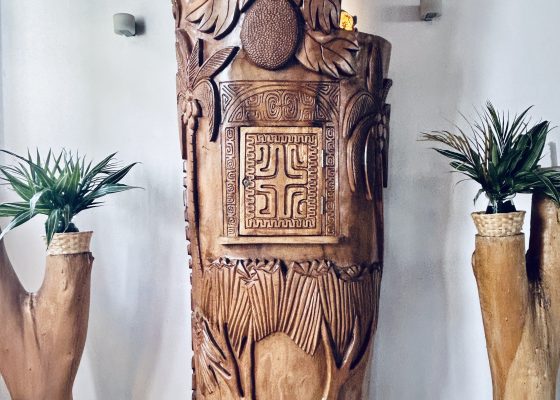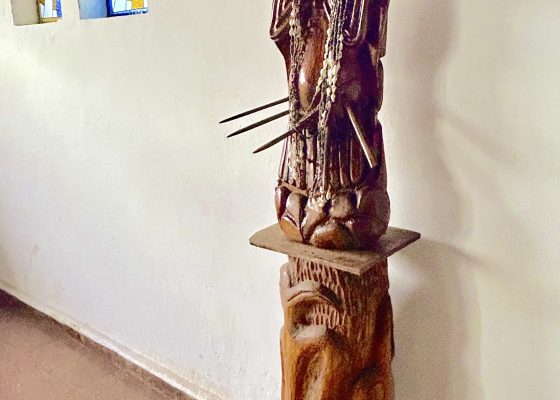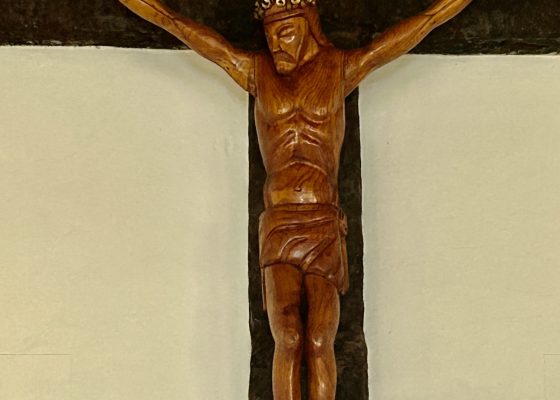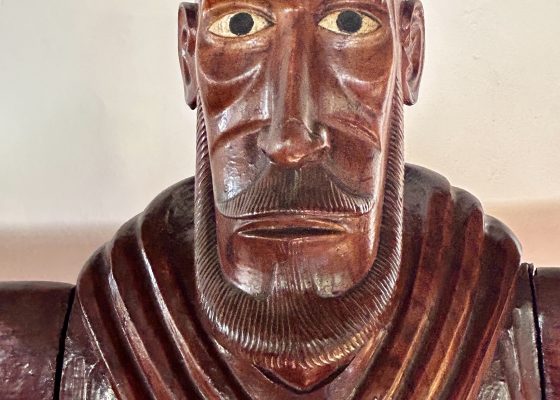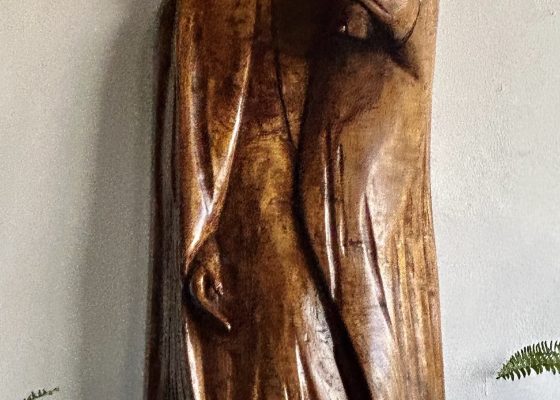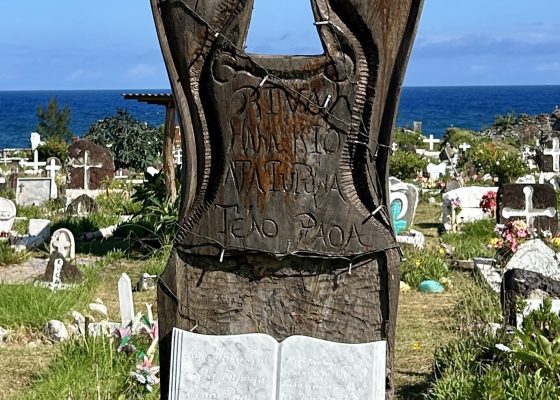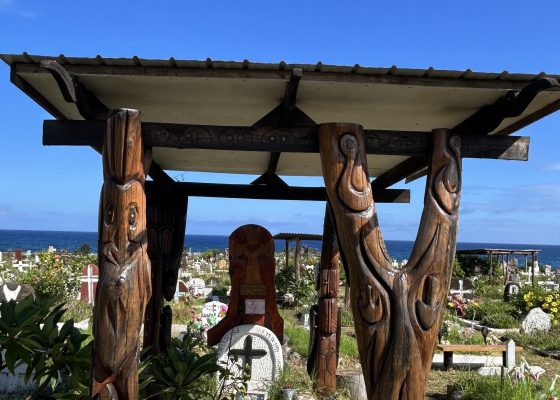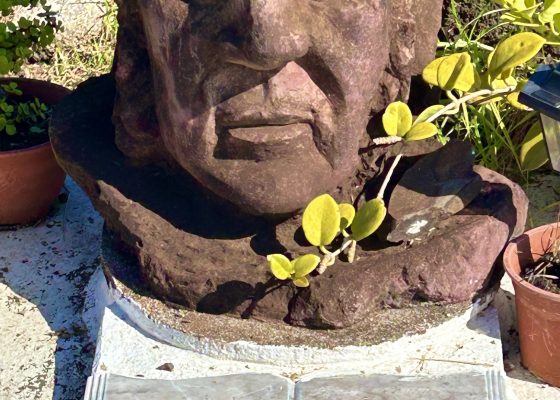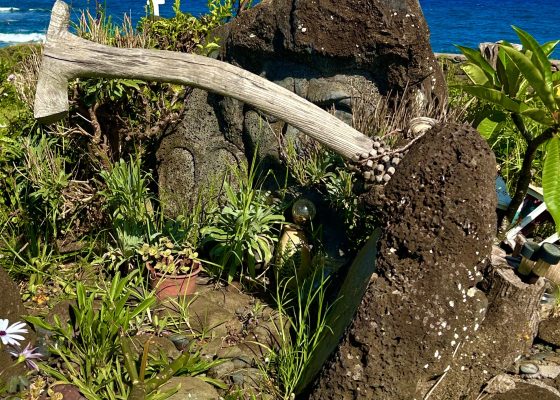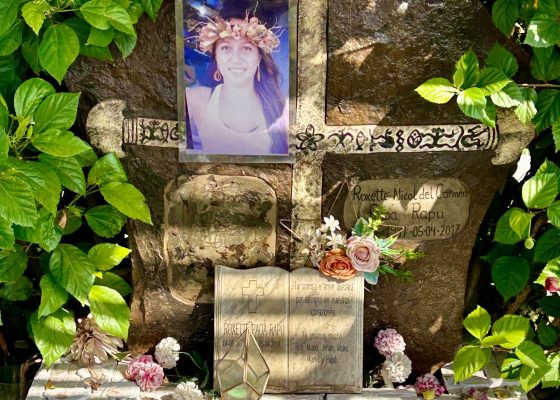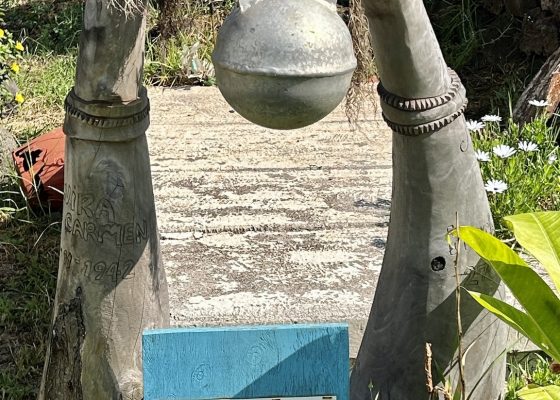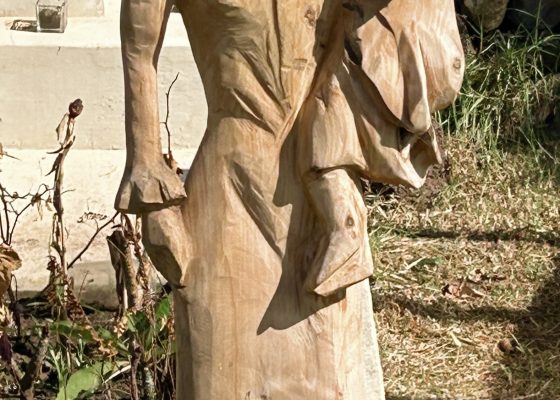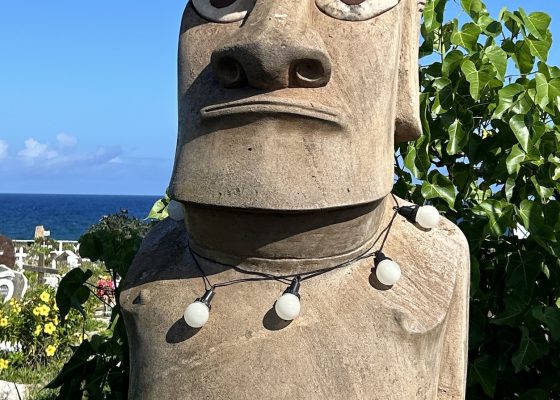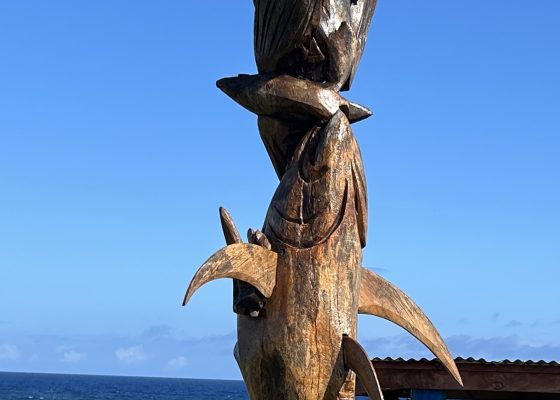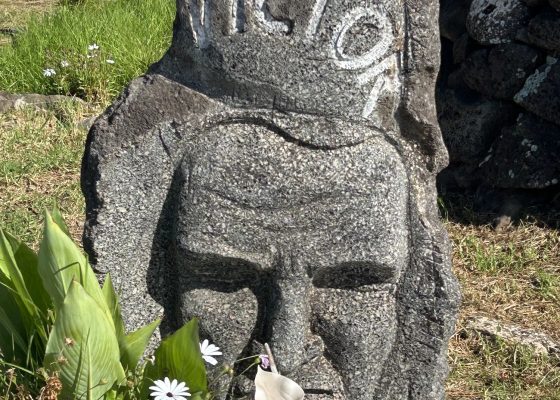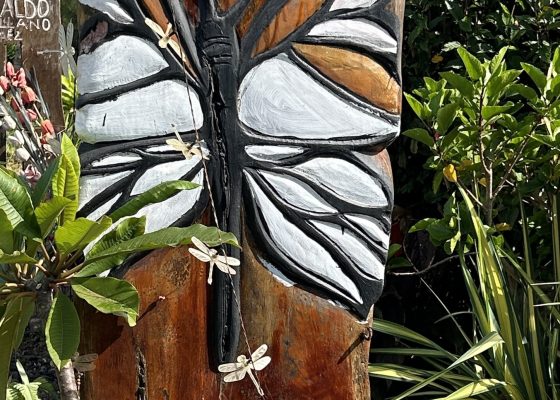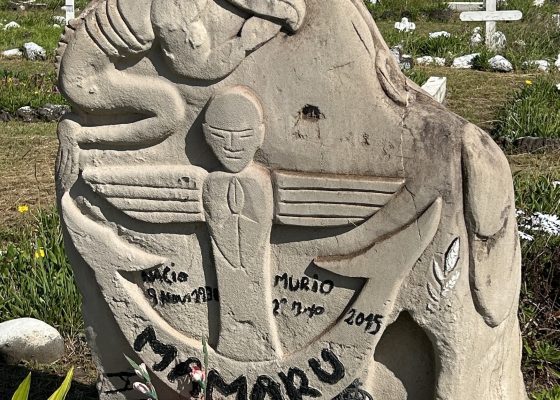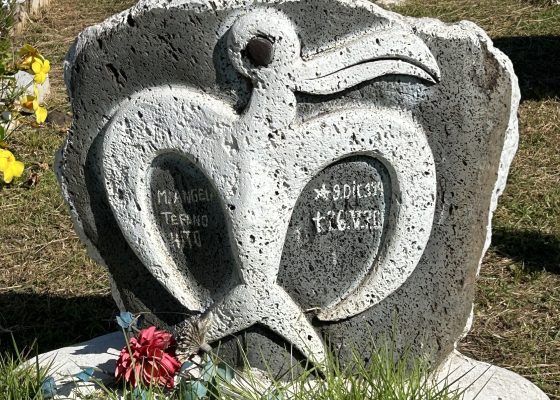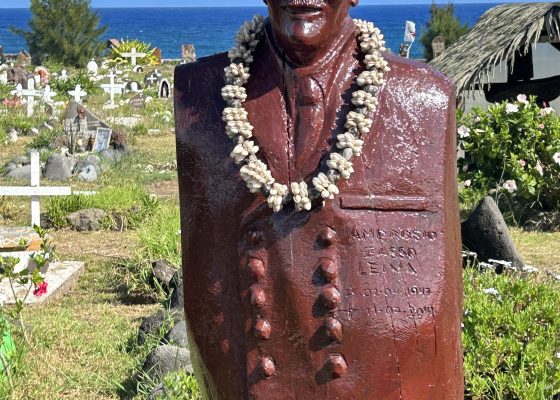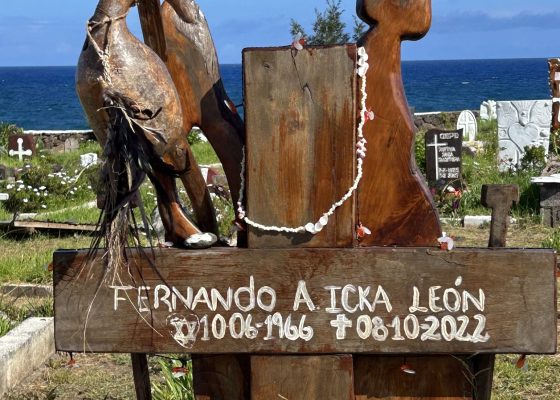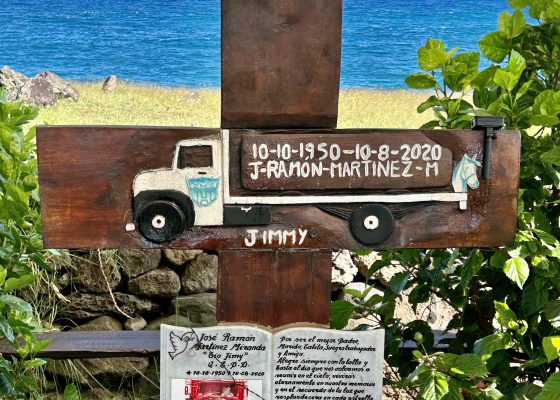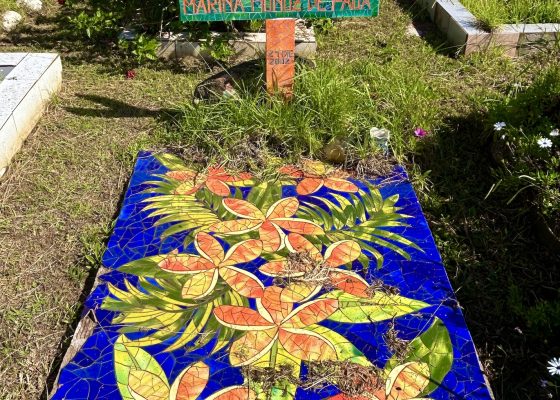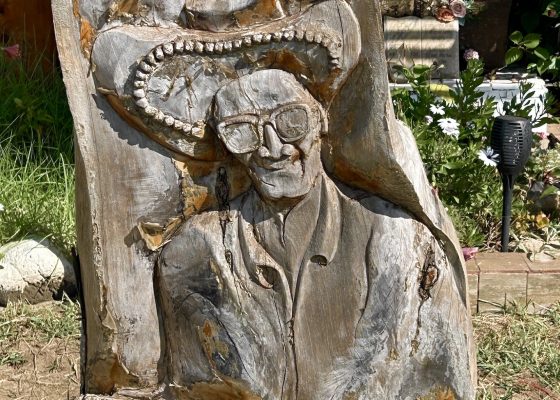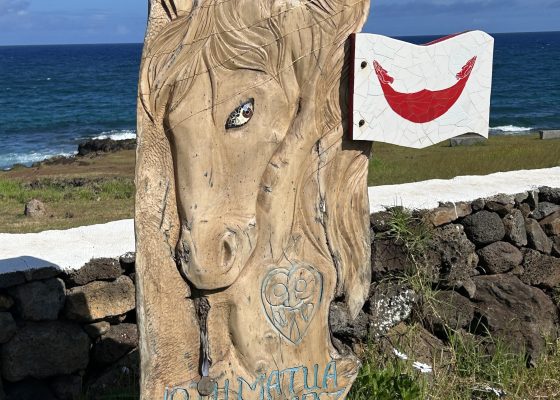Rapa Nui – Here at Last
Alison and I originally signed up for Adventures Abroad’s extensive Chile trip before Covid and when trips to Chile resumed after Covid there was no guarantee that the Rapa Nui would be included so we decided to wait. That was hard – Rapa Nui has been right up there with the Pyramids, Angkor Wat and only a few other places, that I had to visit before I died. The pyramids, Egyptian, Aztec and Mayan have been seen in person as has most recently, Angkor Wat. Rapa Nui was finally guaranteed on the March 2024 departure and now at last I’m about to board a plane in Santiago for the almost six hour flight to this most exotic of all locations. Hop on board to find out why this place has such an allure for the sixteen AA patrons about to make the trip.
History of Rapa Nui
First of all let’s clear up one thing, it’s not Easter Island as most of us have known the island since our inception. That was a name given by Dutch explorer Jacob Roggeveen, the first European to set foot on the island on Easter Sunday in 1722. He actually called it Paasch-Eyland, which is Dutch for Easter Island. Thank God that name never stuck, but the English translation did for several hundred years until gradually being replaced by Rapa Nui, which is the official name today. Interestingly Rapa Nui is not an ancient name for the island, but only came into use in late 19th century. Older names include Te Pito o Te Hunua and Mata-ki-te-rangi so Rapa Nui is a joy to say in comparison to those other two. ‘Nui’ means big in Polynesian and that adjective separates it from another Rapa in the Austral Islands that has the adjective ‘iti’ meaning little.
Rapa Nui is the remotest place on earth. No other piece of land is so far removed from another inhabited piece of land. It’s 3,500 kms. (2174 miles) to the coast of South America. The closest inhabited piece of land going west is Pitcairn Island which the Bounty mutineers fled to thinking that it was about as far off the beaten track as you could get, and yet it’s still another 2,060 kms. (1280 miles) from there to Rapa Nui. Going east it is 1,850 kms. (1,150 miles) to the Juan Fernandez Islands. Thus it is not at all surprising that it became one of the last places on earth to see the arrival of human beings and there is no consensus on when this happened with dates as early as 300 and as late as 1200 for the arrival of the first colonists.
Colonists might seem to be an inappropriate word as we in the west associate it with people founding settlements in places where other people already lived. However, in Polynesia almost all of the islands were first settled by peoples deliberating seeking out new lands on which to start a new life.
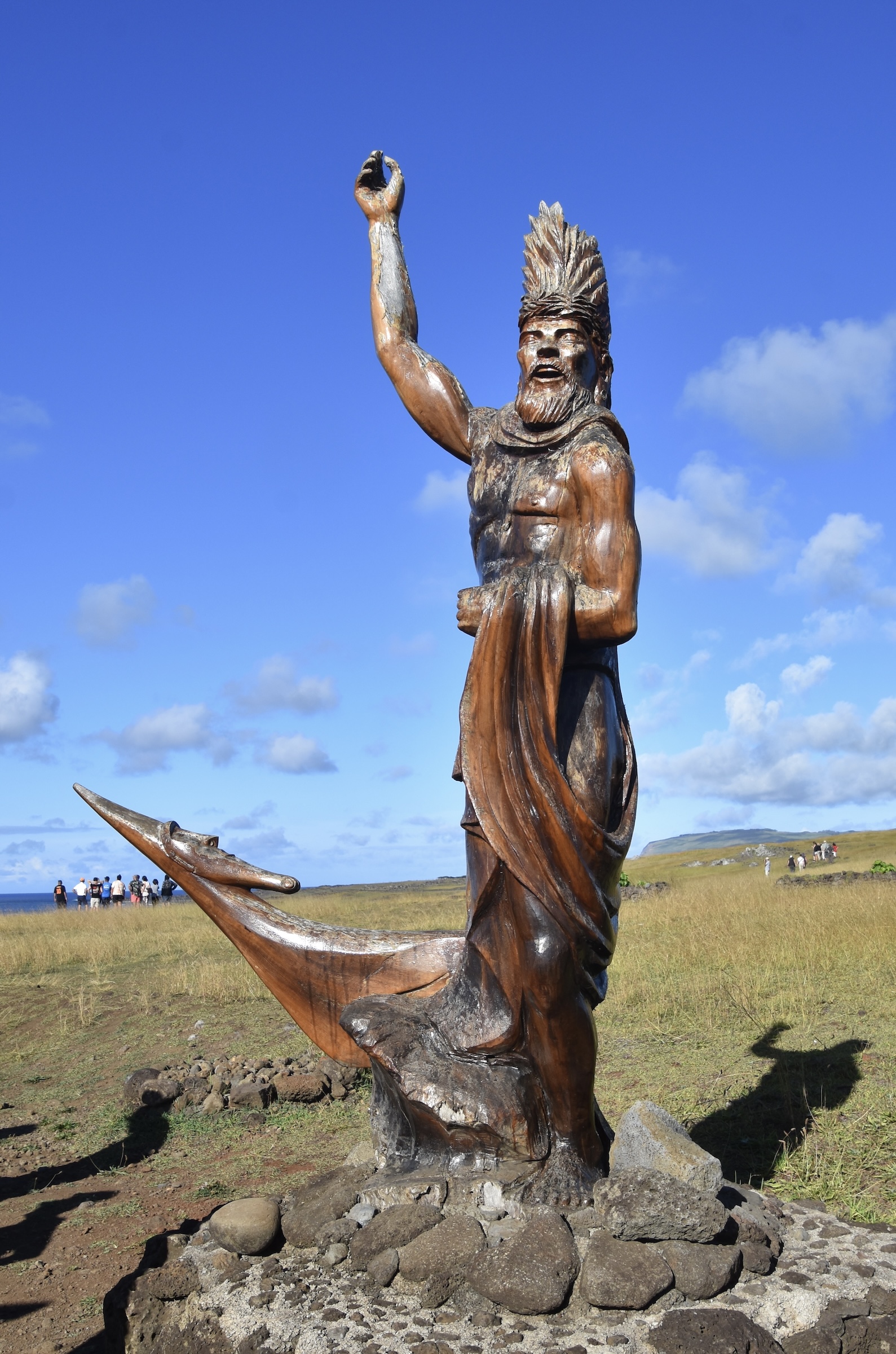
While the date of settlement is up in the air, there is still a very strong oral tradition that a man named Hotu Matu’a was the leader of the expedition that landed at Anakena beach and established himself as king of the island. Linguists have determined that Hotu Matu’a’s people originated from somewhere in the Marquesas Islands, most likely Fatu Hiva which Alison and I visited on a previous AA tour. They would have found an island thick with palm forests and plenty of arable land to plant the banana and taro plants that were traditionally carried on the voyages of exploration. They also would have brought pigs and chickens to provide meat for their diet and of course, the waters around Rapa Nui were absolutely teeming with fish and other types of seafood. So far away from anyone else that fear of other foreign Polynesian invaders (which was a real concern in many other islands), was not a threat on Rapa Nui, one could say that Hotu Matu’a had led his people to a veritable Garden of Eden.
And that’s the way it was for as long as 500 years or more as Hotu Matu’a’s descendants evolved into ten separate clans that in turn were allied into two distinct ethnic groups, the Hanau Momoko aka the Long-Ears and the Hanau ‘E’epe aka the Short-Ears. The creation of the moai, the totemic statues that have made Rapa Nui famous, are believed to have been created and erected between 1250 and 1500. All told there are 887 of them and there is a general consensus that they represent real ancestors and not gods.
Trouble in paradise began when the island was essentially denuded of trees, especially a now extinct species of giant palm and this is where two distinct and conflicting theories about what happened on Rapa Nui before the arrival of Europeans have arisen. On the one side are those like Jared Diamond who postulated an ‘ecocide’ in his book Collapse: How Societies Choose to Fail or Succeed brought on by environmental destruction which in turn led to a manic attempt to ward off destruction by building the moias, further exacerbating the problem and leading to a civil war in which almost all the inhabitants were killed. On the other side are those who fervently believe that all the problems on Rapa Nui were caused by the arrival of the Europeans and that before then everything was fine. Except that there is absolute proof that the island was denuded and that many plant species found on Rapa Nui before humans arrived were extinct by the time Europeans arrived. This is dismissed as the work of the rats the Polynesians brought with them by the anti-Diamond faction.
There is an oral tradition that there was a civil war between the Long-Ears and the Short-Ears wherein all but one of the Long-Ears was wiped out, but there is not a lot of archaeological evidence to back that up. The great majority of Long-Ear skeletons do not show marks of violence.
One thing both sides agree upon is the Tangata manu or Birdman competition, because this was still going on until banned by Christian missionaries in the 1860’s. I won’t go into any more detail here as we will be visiting the site of the competition, but I do urge readers who are hoping to go to Rapa Nui to watch the film Rapa-Nui which centres around this incredibly difficult antecedent to an ironman race.
Civil war or not, when Jacob Roggeveen arrived in 1722 and as late as 1770, the infrequent visitors were blown away by the standing moais. Then when Captain Cook arrived in 1774 he noted that many of the statues had been toppled. This continued until, by the mid 1800’s, only a few in the most remote areas were still standing. While no effort to introduce European colonists to Rapa Nui was ever attempted, things got really bad for the Rapa Nui people when Peruvian slavers arrived in 1862 and carried off over half the residents. This included the recognized ruler and his family who were the only ones who could read the rongorongo script which was a form of proto-writing unique to Rapa Nui and one that has not been deciphered to this date. Much that is a mystery today might have been known, but for the Peruvian enslavement.
The enslavement era had an even more deadly turn when a number of the kidnap victims were returned to Rapa Nui and promptly spread tuberculosis throughout the island reducing the population to less than 1,000. Then the French got into the act and transported almost all the able bodied residents to Tahiti and the Gambier Islands. By 1877 97% of all Rapa Nui residents were dead or removed leaving only 111 people on the island and that dropped to 101 by 1892. Almost all of the people who identify as Rapa Nui are descended from the remaining three percent.
Things didn’t get much better when Chile supposedly ‘bought’ Rapa Nui in 1888 from one Alexander Salmon Jr. whose mother was a Tahitian princess. While Chile was in effective control from that date onward, it in turn allowed the sale most of the island to an English sheep farming concern that ran the island until 1953 almost like a penal colony. Residents were not allowed to leave the settlement of Hanga Roa until 1960. Only in 1966 were they given Chilean citizenship.
Things finally changed for the better when the Mataveri International Airport opened in 1965 and the first tourists began to arrive. Suddenly, Rapa Nui had some value to Chile other than as a naval base and things have progressed exponentially since then although not without clashes between the locals and the Chileans over a number of issues, most notably land ownership and fishing rights.
Today there are still only about 7,750 permanent residents and post-Covid they entertain about 100,000 tourists a year which is the mainstay of the economy. Efforts to restore the moais have been ongoing for many years and continue with the support of foreign governments, particularly Japan. It does appear that after what can only be described as one of the most hellish periods in history for any given people, the future looks better than it has since the first colonists arrived with Hotu Matu’a all those years ago.
In 1995 Rapa Nui National Park was designated a UNESCO World Heritage Site with this inscription:
Rapa Nui, the indigenous name of Easter Island, bears witness to a unique cultural phenomenon. A society of Polynesian origin that settled there c. A.D. 300 established a powerful, imaginative and original tradition of monumental sculpture and architecture, free from any external influence. From the 10th to the 16th century this society built shrines and erected enormous stone figures known as moai , which created an unrivalled cultural landscape that continues to fascinate people throughout the world.
With that rather lengthy introduction let’s start exploring Rapa Nui beginning with our accommodations and the village of Hanga Roa
Hanga Roa
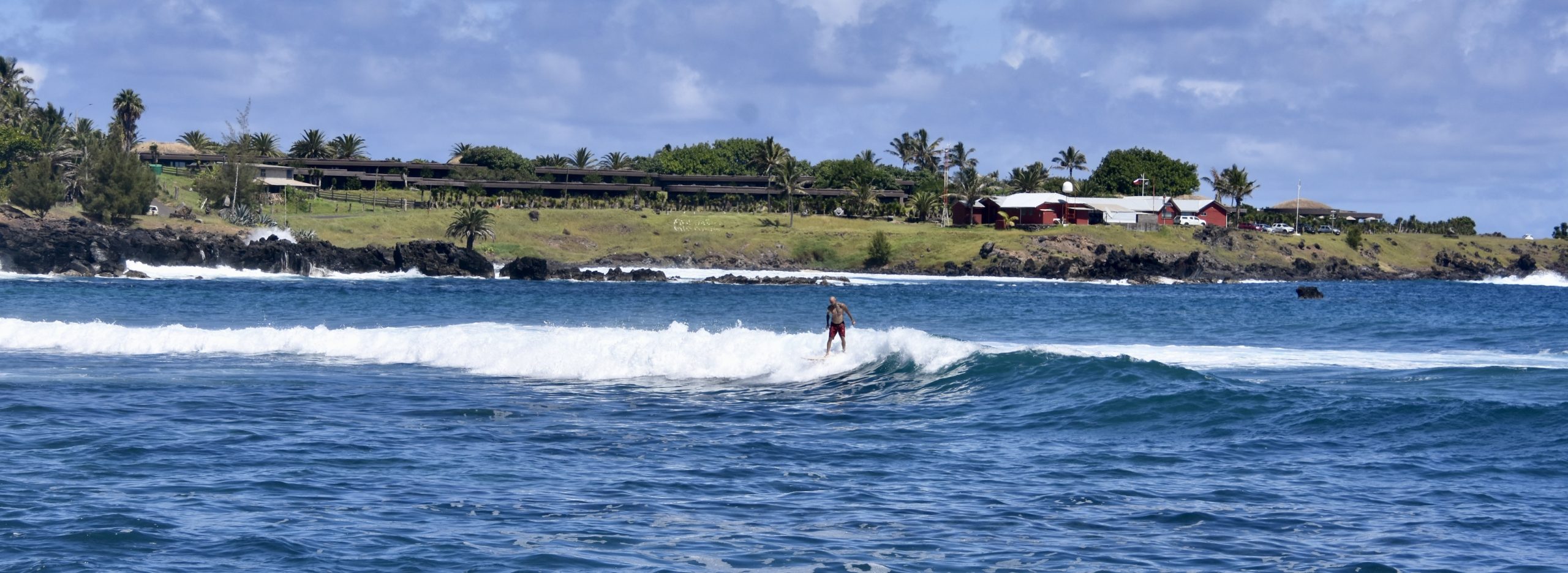
After a relatively uneventful Latam flight from Santiago we landed at Mataveri Airport which is literally right in the middle of Hanga Roa, the only town on Rapa Nui and where 95% of all residents live. From here it was a short drive to the Iorana Hotel where we would spend the next four nights. There are no accommodations on Rapa Nui affiliated with major chains and all are located in or close to Hanga Roa. The Iorana was about a pleasant 20 minute walk from the waterfront and the main street.
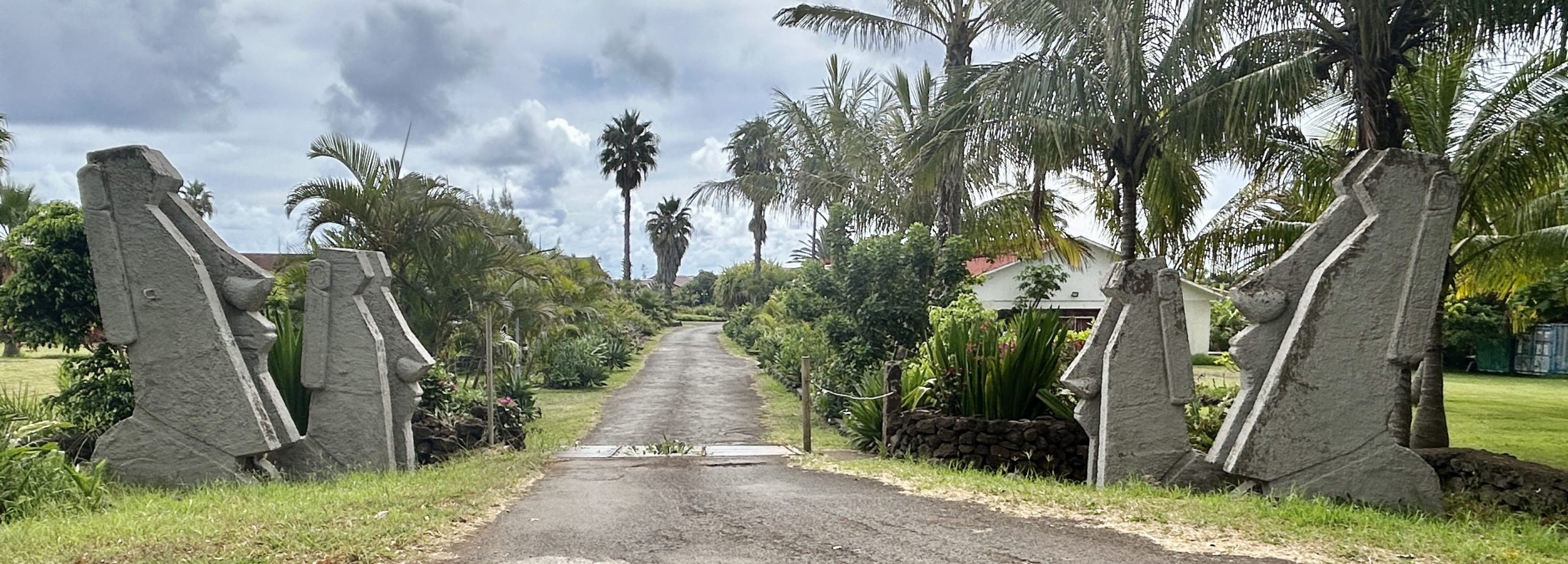
While not luxurious, the Iorana has great views, a refreshing pool which I did actually use and beautiful sunsets.
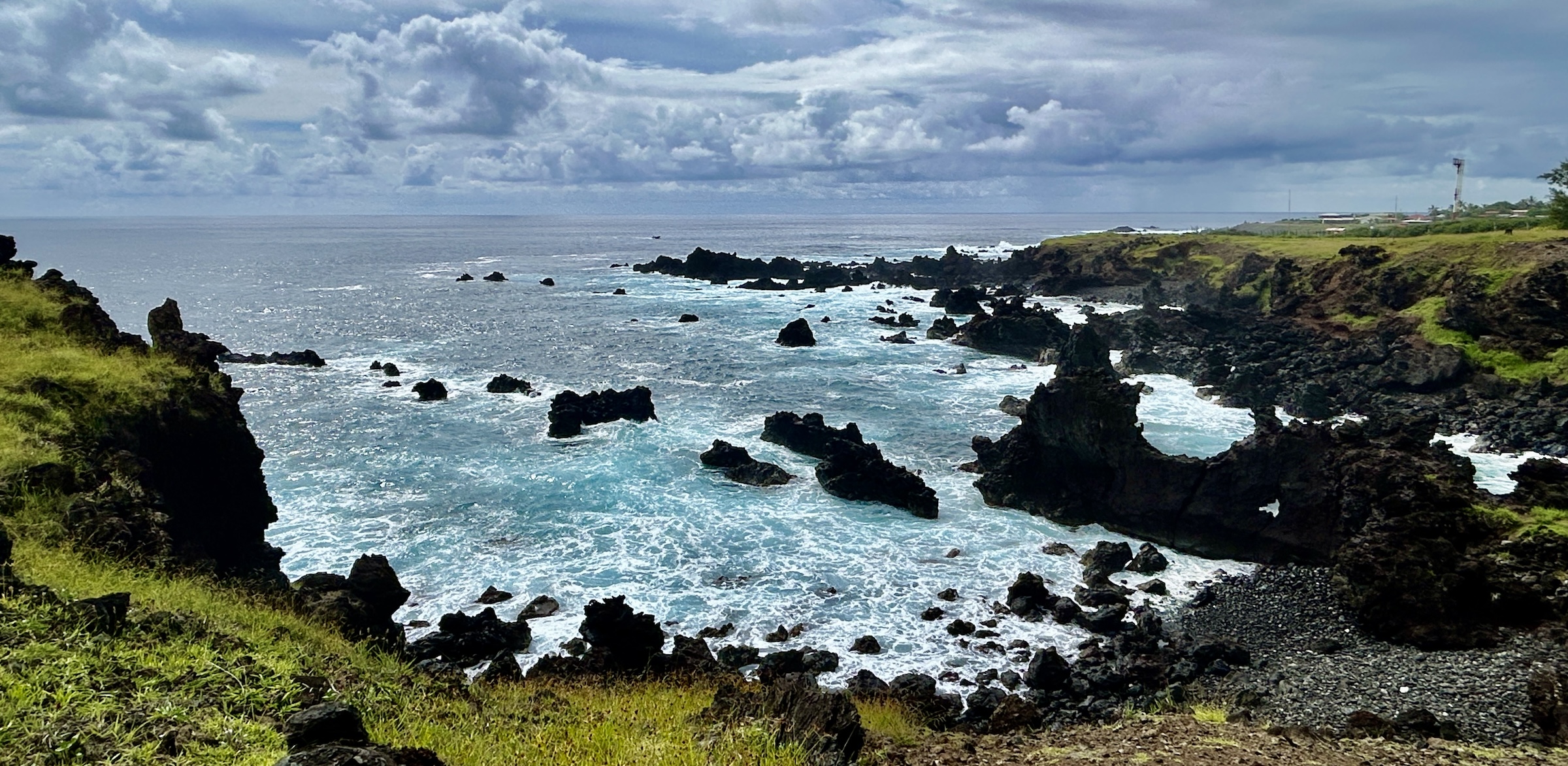
It also had its own collection of miniature moais just in case you forgot the reason you came to Rapa Nui in the first place.
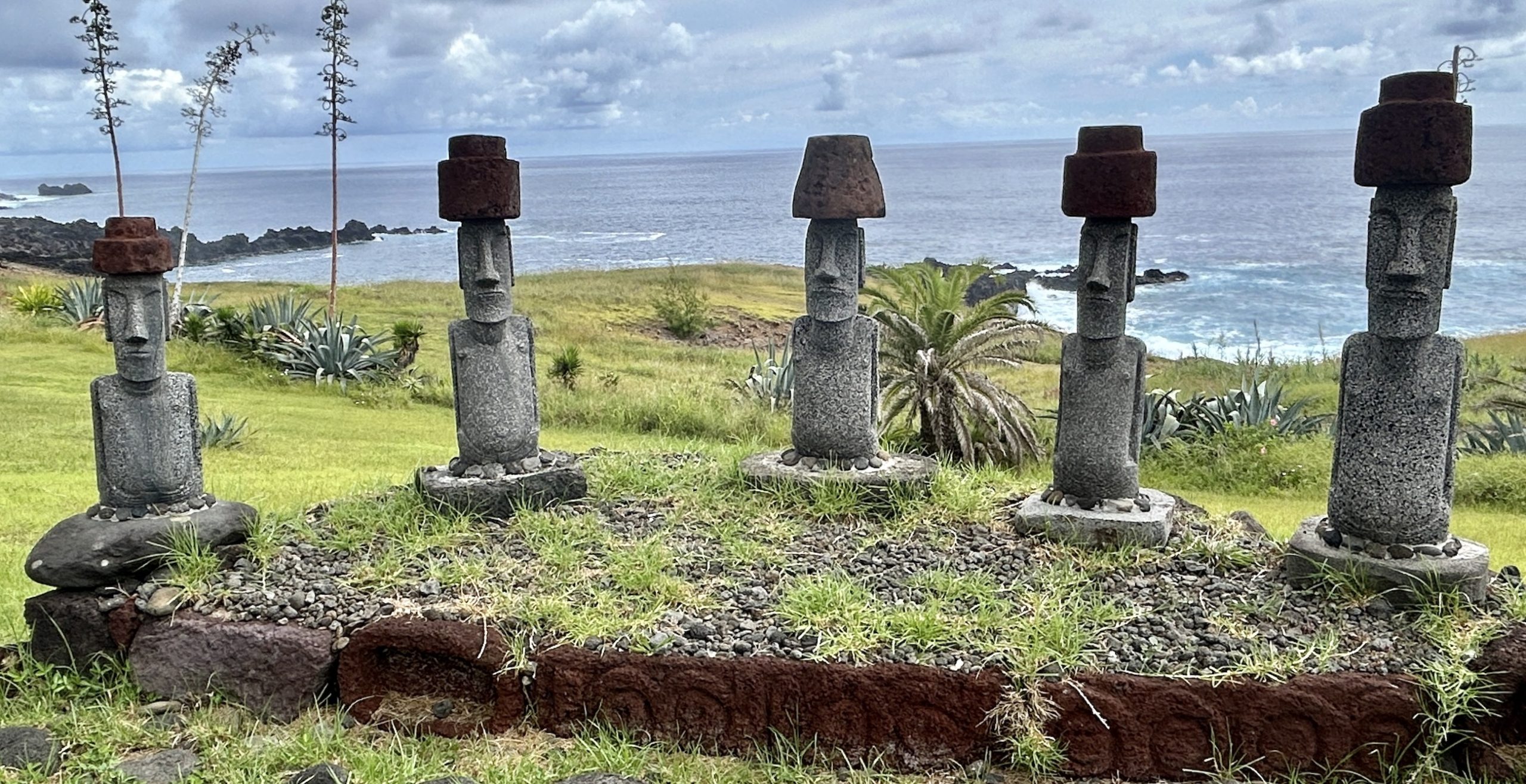
The Rapa Nui itinerary is not onerous with plenty of free time which Alison and I used to explore Hanga Roa on three different occasions, finding something new each time. Although this is definitely part of Polynesia, Rapa Nui reminded me just as much of some of the drier Galapagos Islands and Hanga Roa of the small villages on them. While Rapa Nui has nowhere near the wildlife that the Galapagos does, the vibes of these remote islands are quite similar.
This is where we encountered our first real moai which stands in front of the small cove at Hanga Roa. As I was to learn later, all the moais are erected on a platform called an ahu and this one bears the name Ahu Hotake. I also learned something from this first moai that up until then I had 100% wrong. I had always just assumed that they faced outward looking at the ocean when the opposite it is the case – they all look landward. The usual explanation is that by the time the people of Rapa Nui began building the moais, hundreds of years after their arrival, they believed they were the only people on earth. Any threats to their peace would only come from somewhere else on the island and not from the sea.
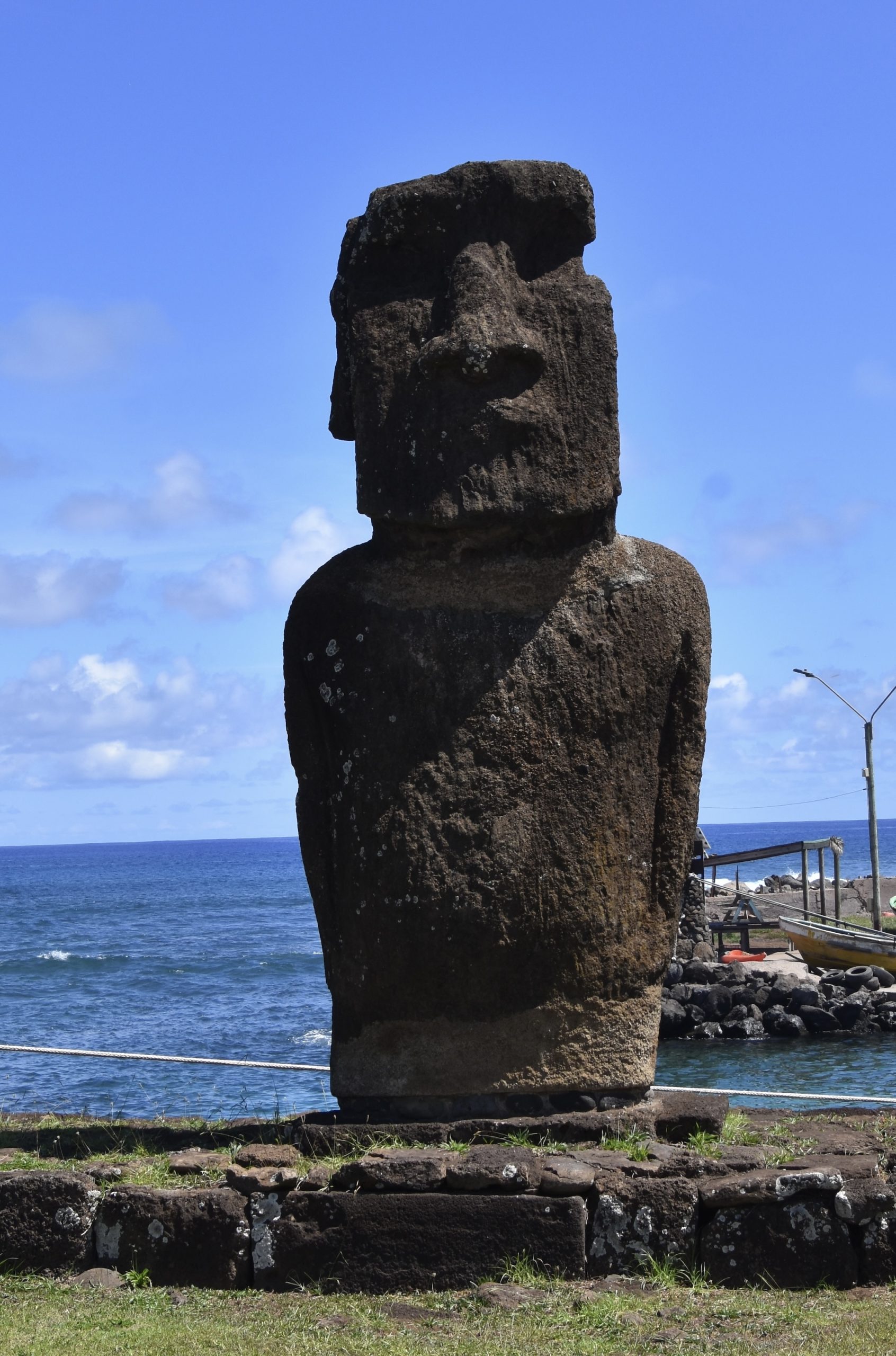
The Hanga Roa pier is an interesting place to explore with small fishing boats on one side and restaurants, dive shops and souvenir booths on the other.
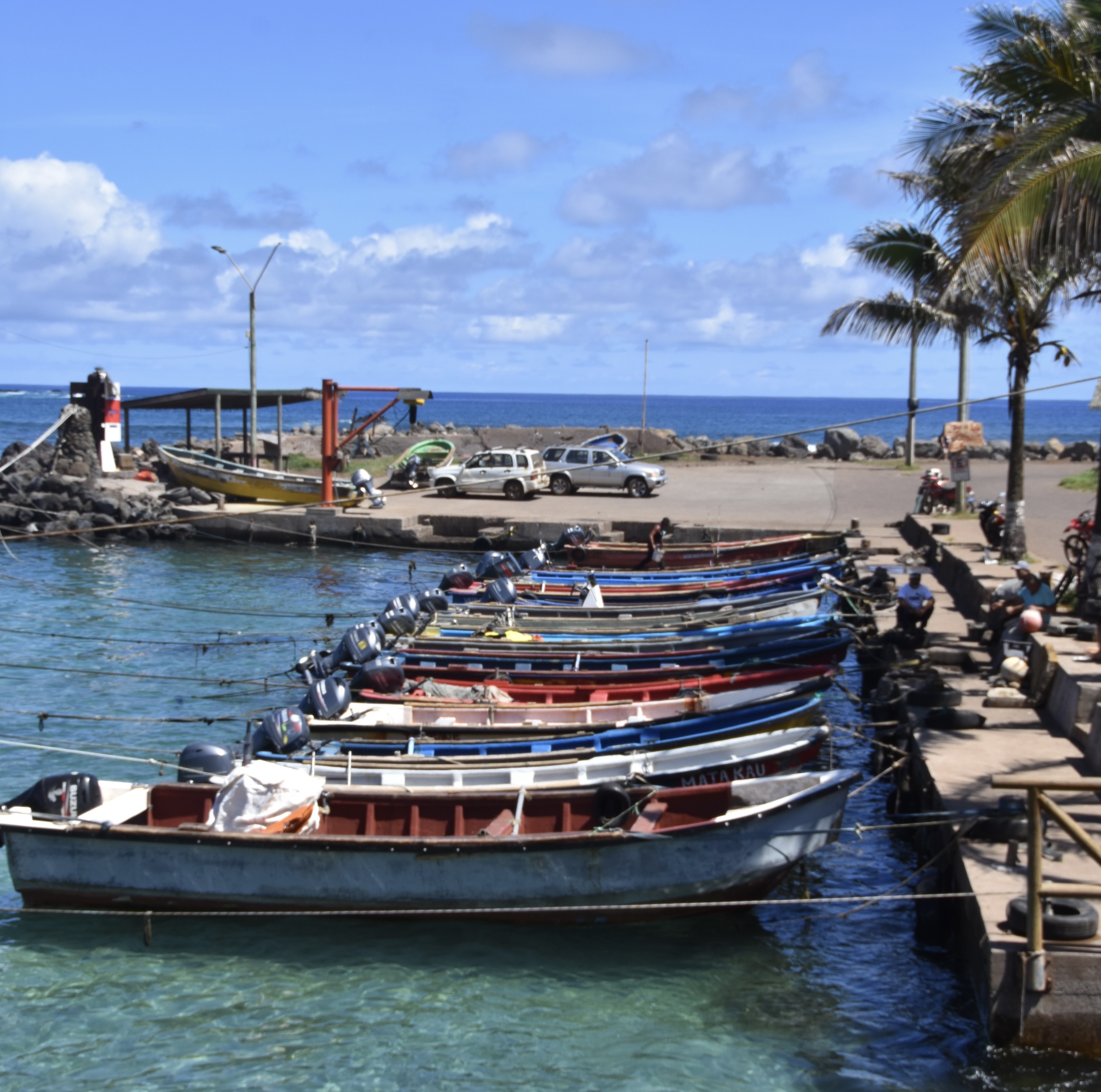
Green sea turtles also hang around the pier.
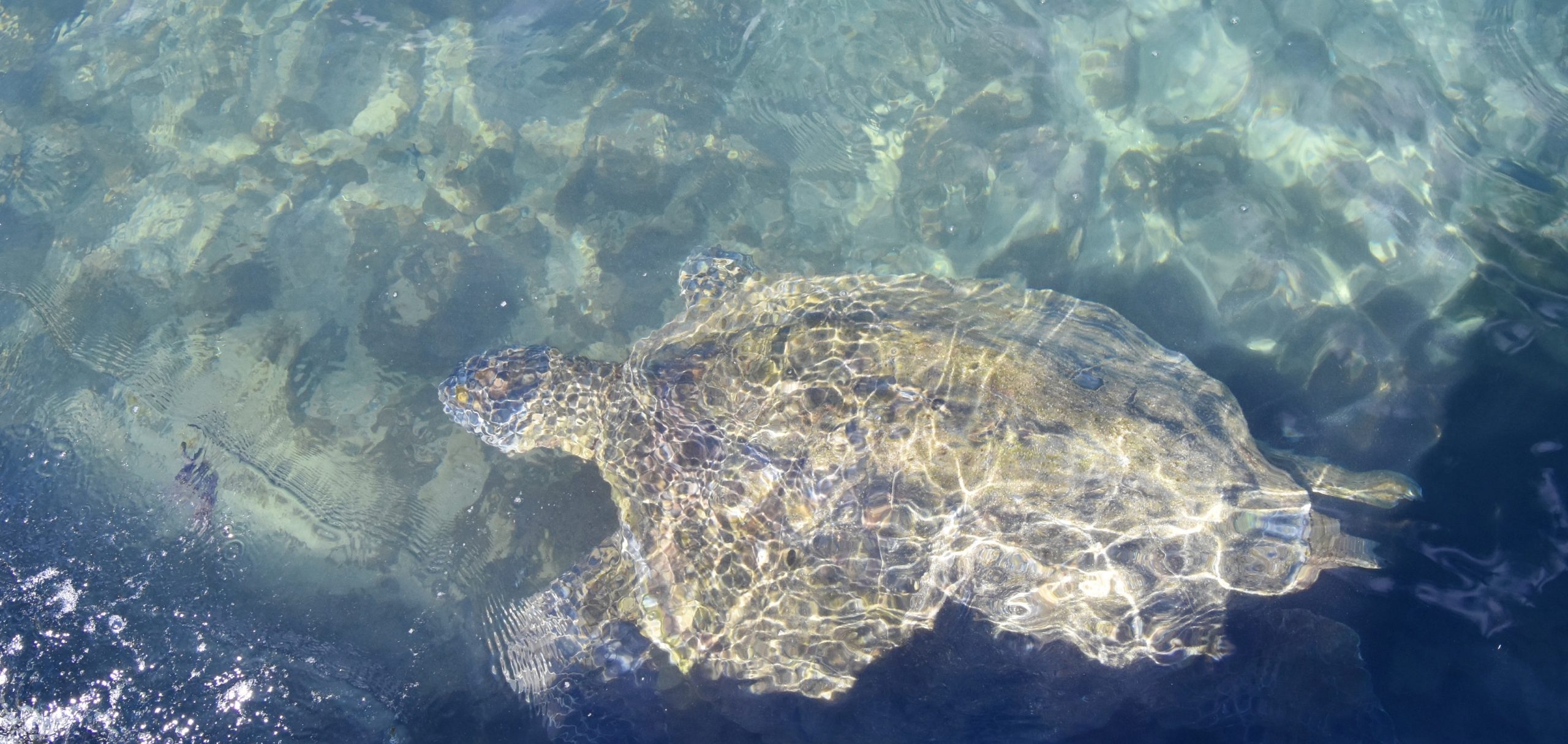
As do tons of fish.
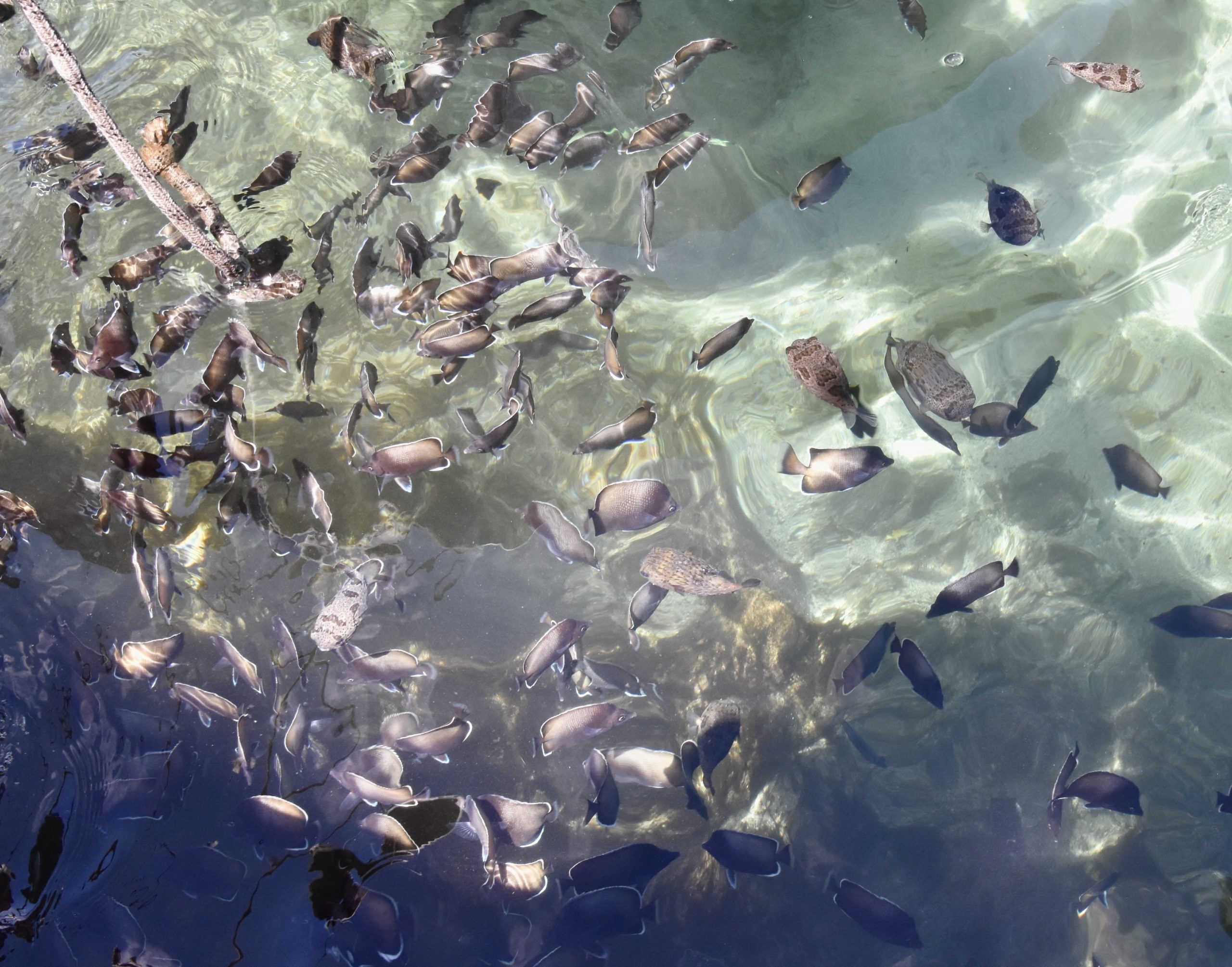
It’s also a great place to watch the surfers. They don’t bother to paddle out, but just dive right into the surf from the rocks at the end of the pier.
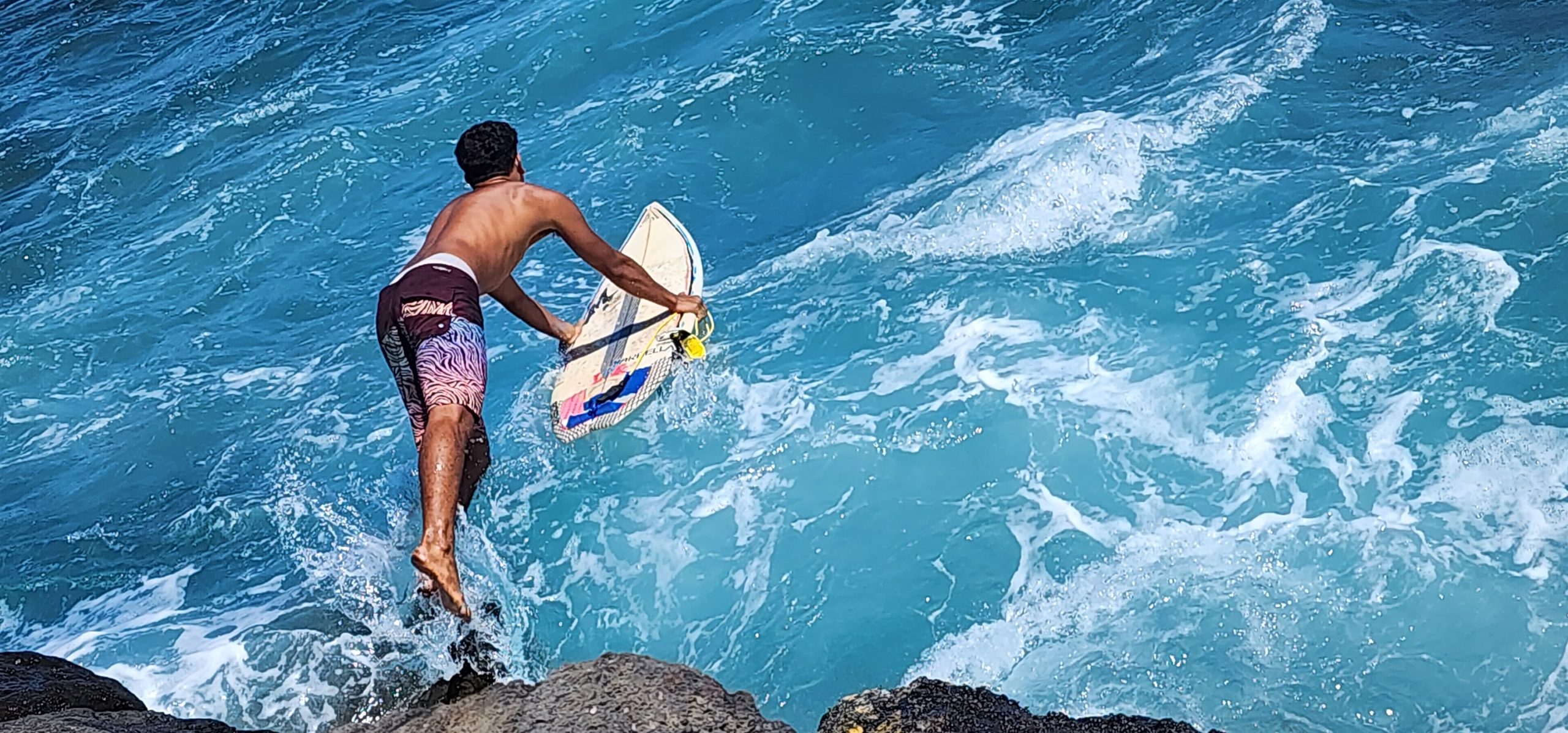
Other places worth visiting in Hanga Roa include the Catholic church which with its beautiful wooden carvings is very similar to churches we saw in the Marquesas Islands.
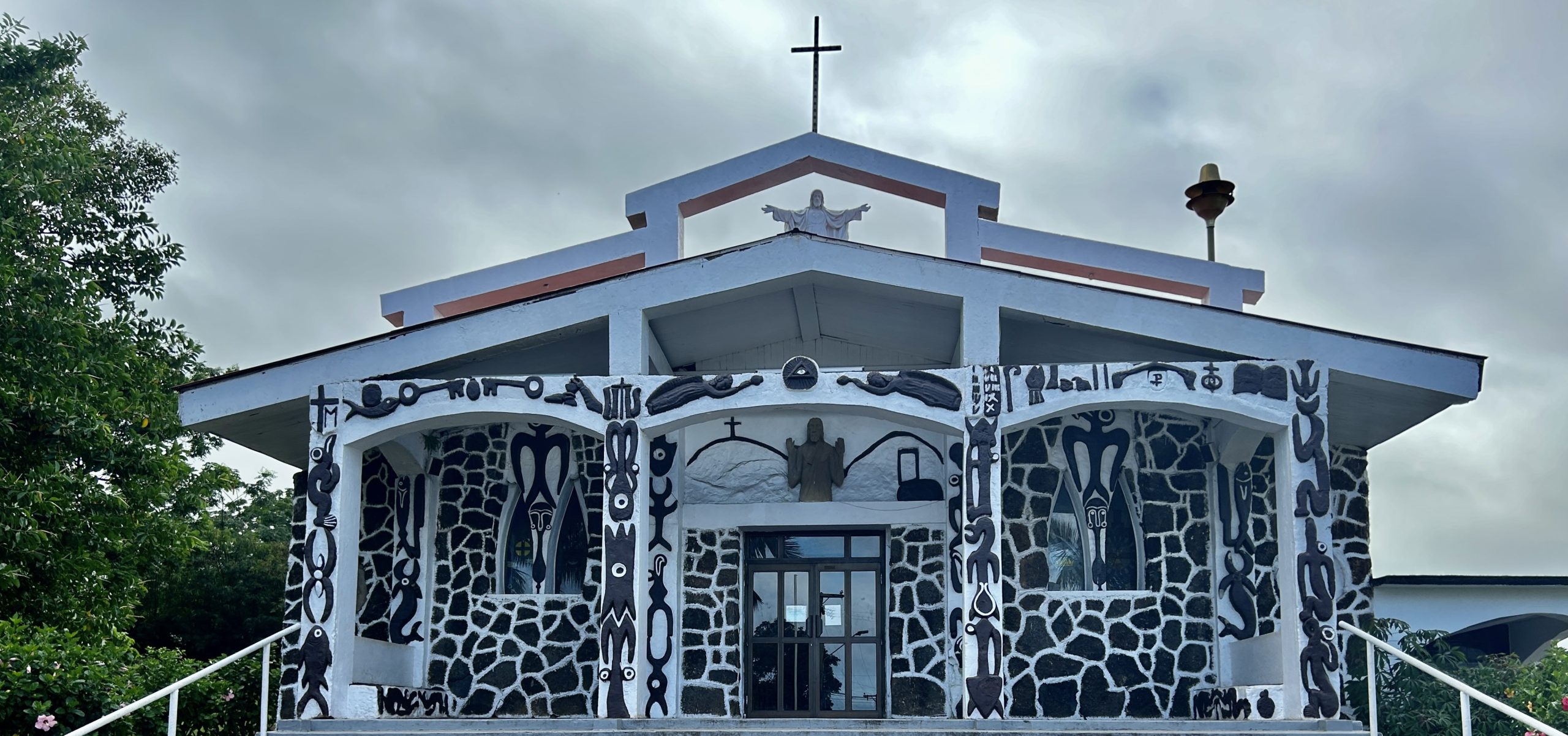
Here is a small gallery of the interior and some of the carvings found inside. Double click to open one and double click again to enlarge.
- Church Interior
- Pulpit
- Birdman
- Christ with a Polynesian Headress
- Moai Like Face
- Virgin & Child
Any regular readers of my posts will know that I love exploring cemeteries and Hanga Roa has one that is just loaded with noteworthy grave markers.
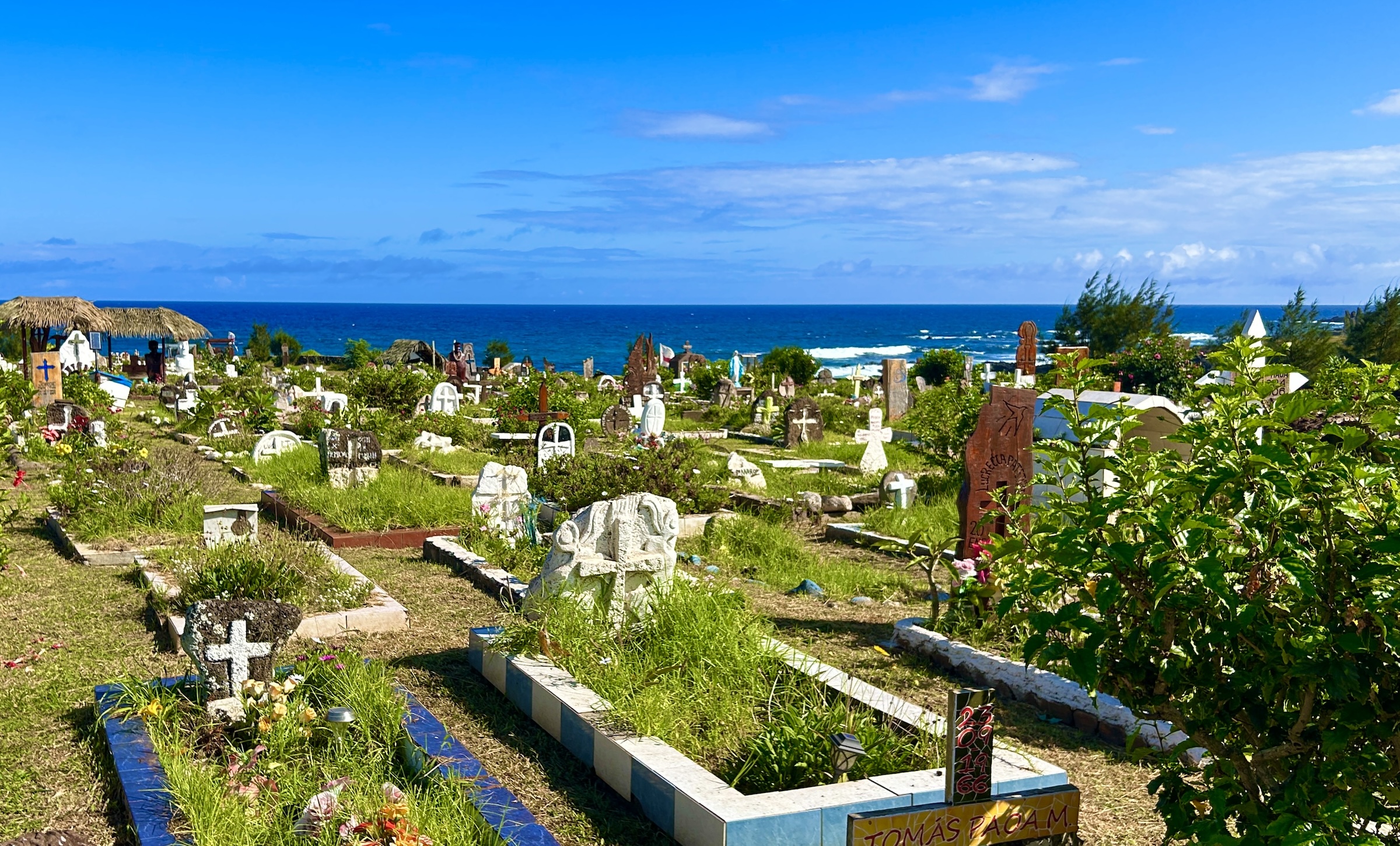
From the back of the cemetery you can look across the small cove and see two substantial moais which we will visit in the next post.
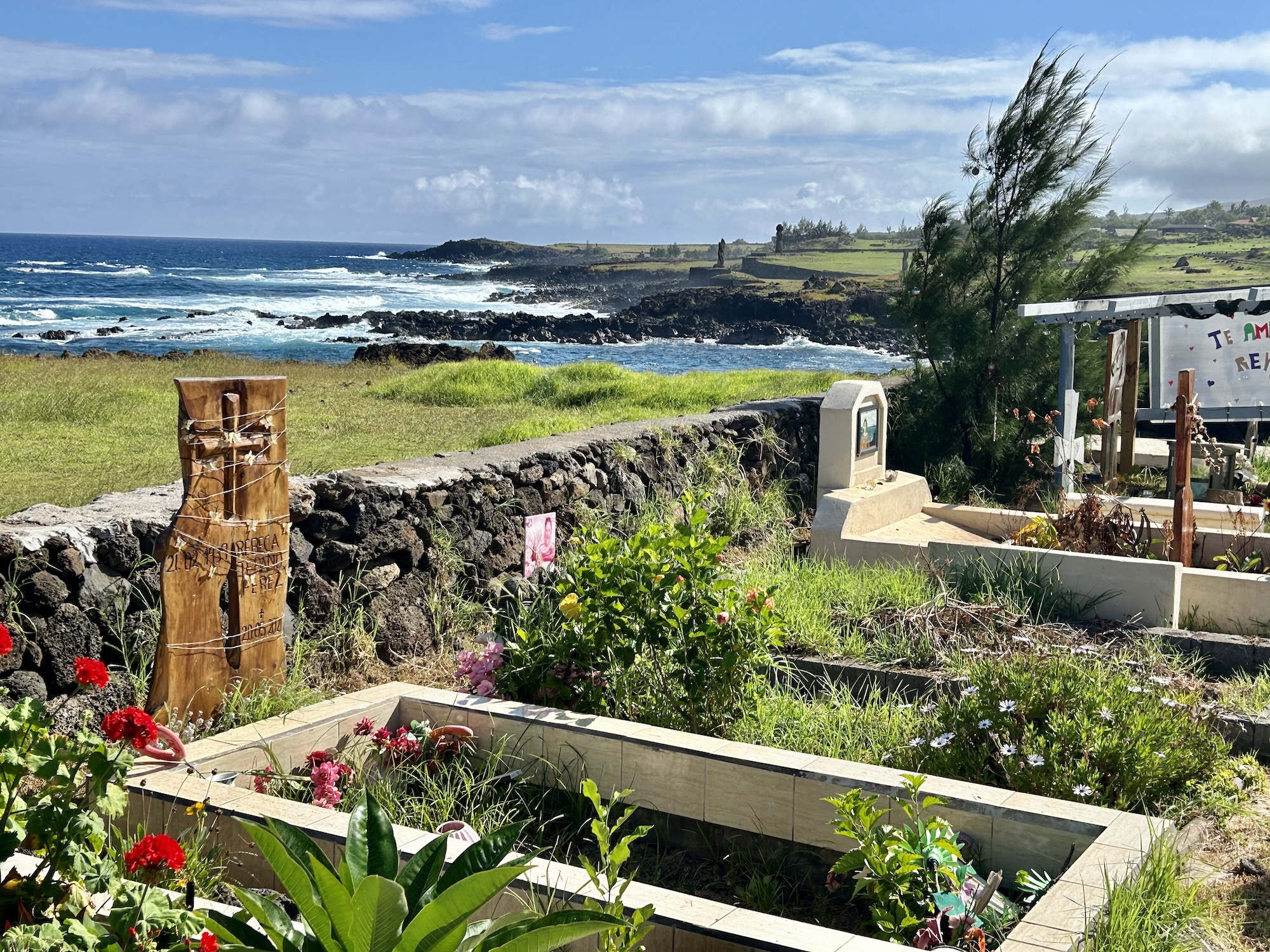
Here is a gallery of some of the most photographic graves in Hanga Roa cemetery.
Next I want to say a little about the food and drink on Rapa Nui. Given that it is so remote, one might expect that the availability of fresh produce would be a problem and to a certain extent that is true, but if you love seafood then this place is paradise. Each night Chris took us to a different restaurant of which there are a surprising number in Hanga Roa and all were excellent as were a few Alison and I visited on our own for lunch. This is a truly amazing tuna carpaccio.
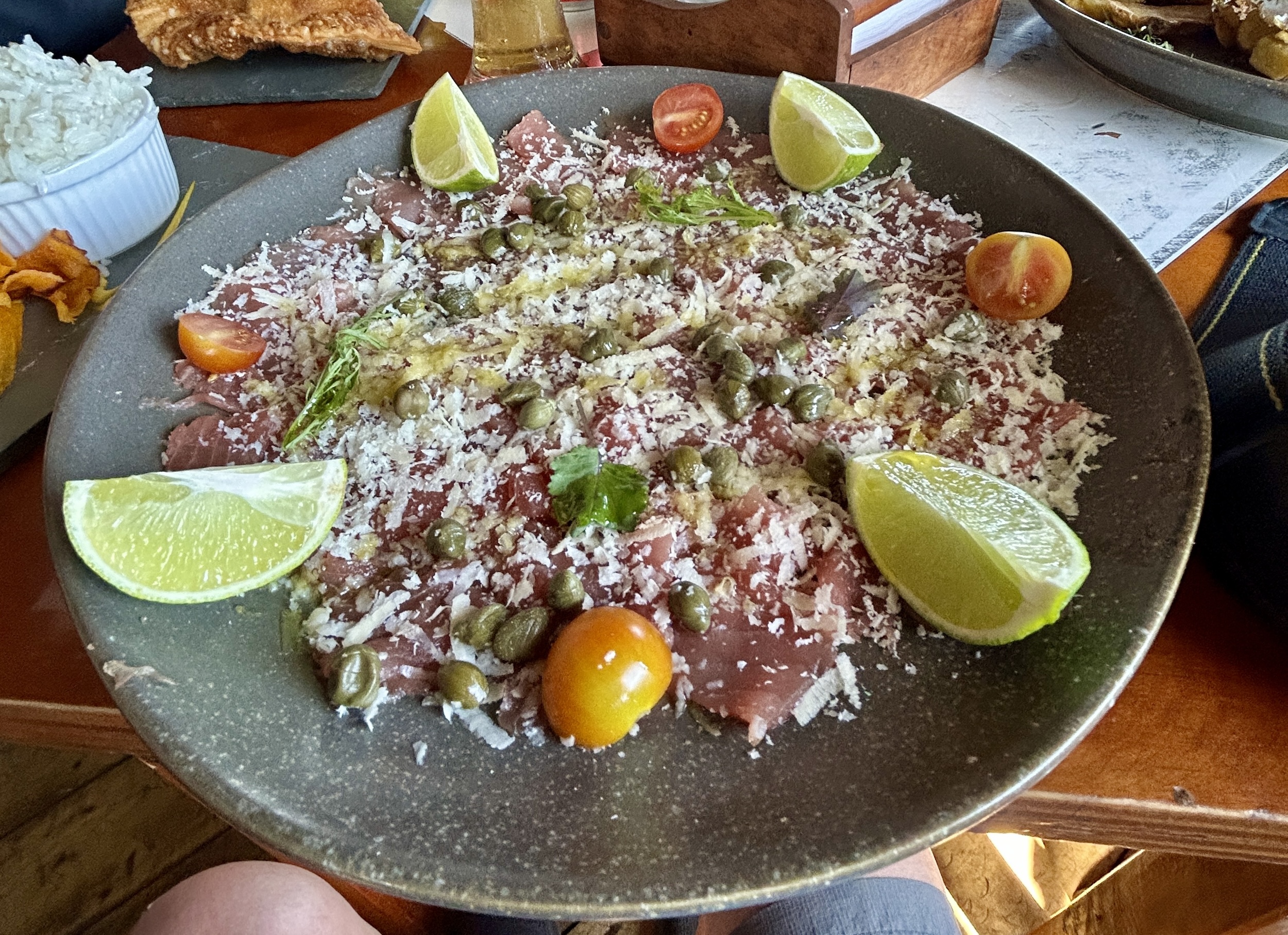
And shrimp pil pil.
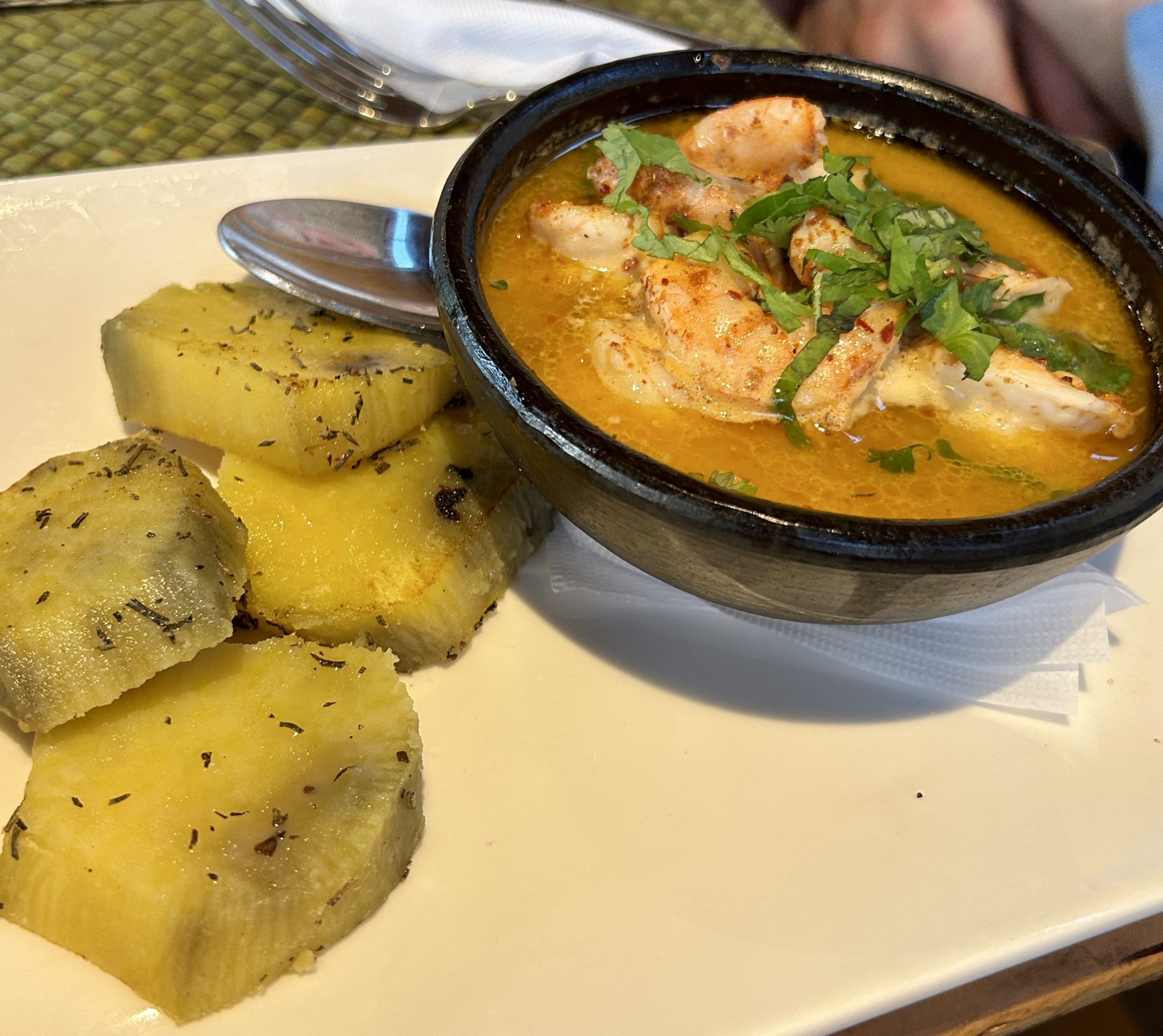
For Chris, the empanada addict, the great news was that the tuna empanada is the go to snack on Rapa Nui.
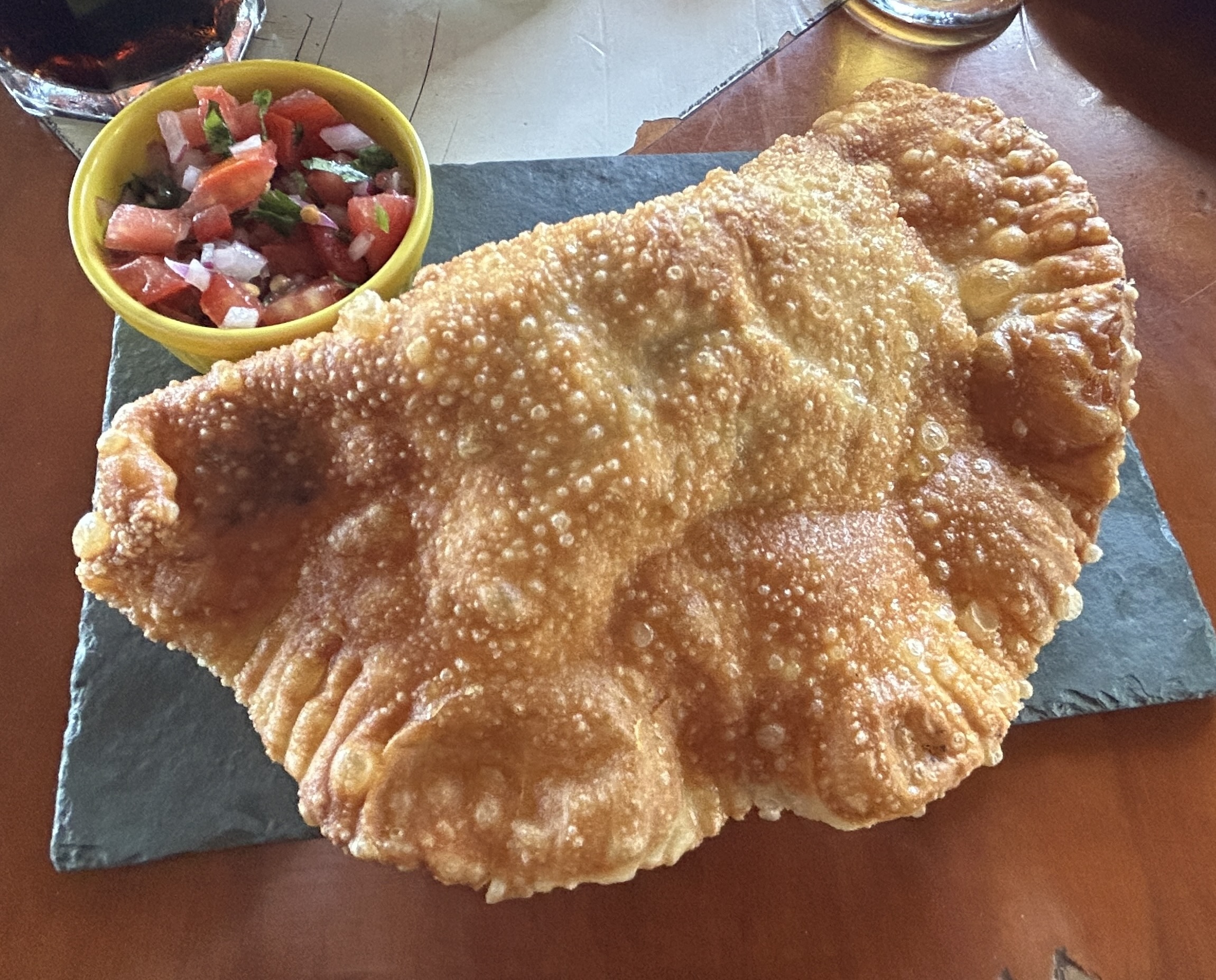
So, even without the moais, there is quite a bit to see and do in Rapa Nui, but we are here to see them and that’s what we’ll do in the final post from Chile. Oh, and did I mention that the sunsets here are surreal?
